5 Best Future Tools AI: Top Picks for 2024 and Beyond
I’ve explored the top five AI tools that’ll shape the future in 2024 and beyond. RenderNet impresses with character design consistency and speed. Truva offers seamless integration and personalized guidance, while Univi provides tailored meditation sessions enhancing productivity. VASA-1 by Microsoft Research brings real-time animation for digital communication to life. Collov AI stands out with real-time art creation, appealing to designers and real estate developers. Each of these tools showcases cutting-edge technology and user-centric features that promise to revolutionize various industries. Stick around to discover more unique aspects of these groundbreaking tools.

Main Talking Points
- RenderNet: Offers cost-effective, user-friendly character design and secure data encryption for small businesses and startups.
- Truva: Provides AI-driven personalized guidance with seamless integration and robust data security for SaaS, educational tools, and e-commerce.
- Univi: Delivers AI-tailored meditation sessions and interactive learning features to enhance productivity and manage ADHD.
- VASA-1 By Microsoft Research: Utilizes deep learning for real-time facial animation, benefiting entertainment, education, and virtual communication.
- Collov AI: Enables real-time customizable AI-driven art creation ideal for both professional designers and amateurs.
RenderNet – Making Consistent AI Characters
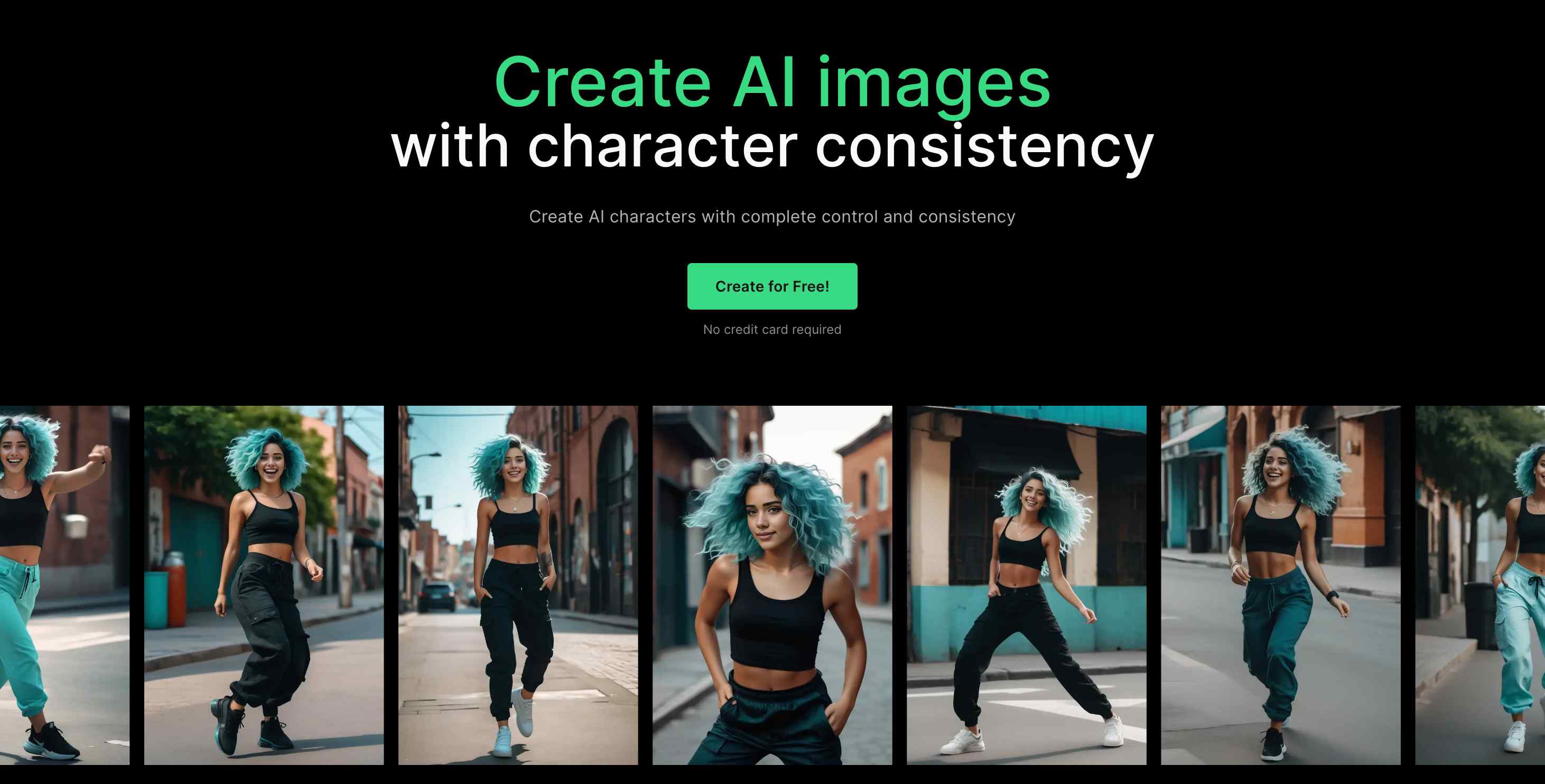
Why should game developers, marketers, and graphic designers consider RenderNet for their 2024 projects?
RenderNet stands out with its all-inclusive suite of features, including FaceLock, ControlNet, ChangeIt, and Multi-model Generations, which streamline and enhance design processes. The tool guarantees consistency in character design, efficiency, and speed, making it invaluable for complex projects like video games, animated series, marketing campaigns, and digital advertising.
RenderNet’s user-friendly interface, combined with robust support through documentation and tutorials, facilitates seamless integration with other design tools, enhancing overall functionality. Additionally, its cost-effectiveness makes it accessible for small businesses and startups.
Prioritizing user security with data encryption and secure servers, RenderNet provides a reliable, innovative solution for modern design challenges.
Best For: Game developers, marketers, and graphic designers who need a versatile and efficient AI tool for complex design projects.
Pros:
- Consistency in character design and visual branding.
- User-friendly interface with comprehensive support and tutorials.
- Cost-effective for small businesses and startups.
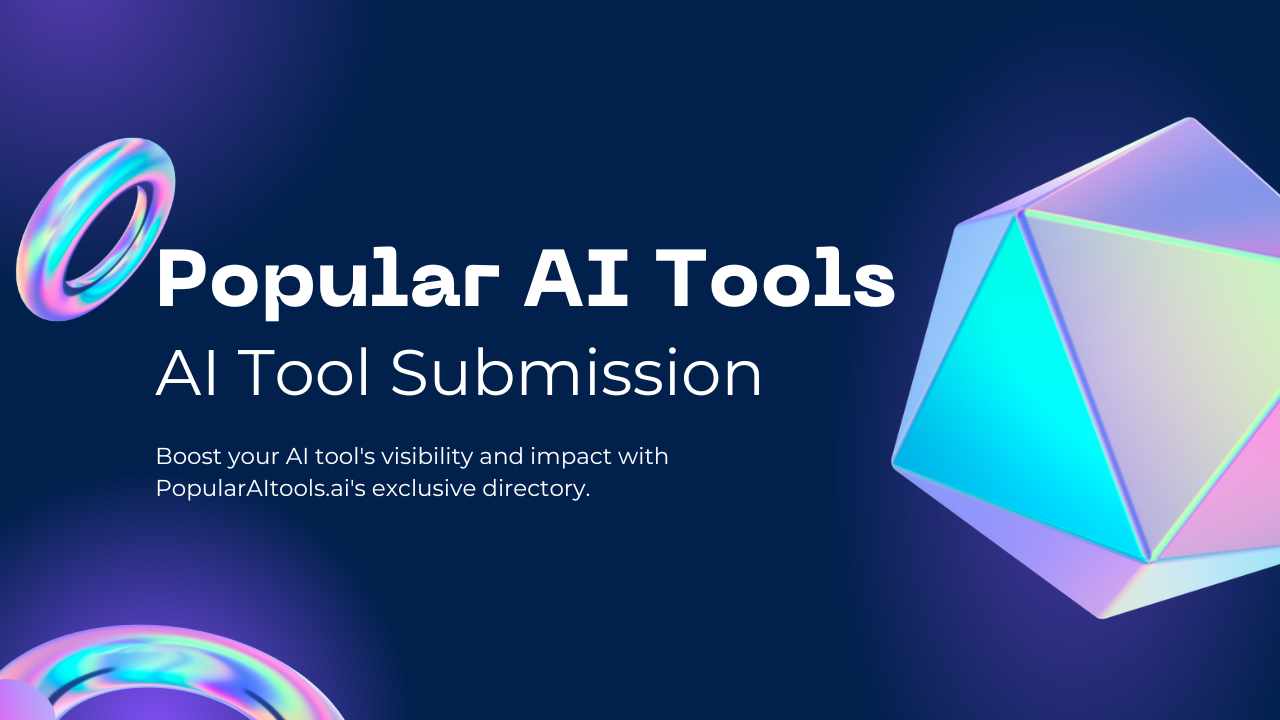
Cons:
- May have a learning curve for new users.
- Requires integration with other design tools for full functionality.
- Advanced features may be overwhelming for beginners.
Truva – AI-Driven Personalized Guidance
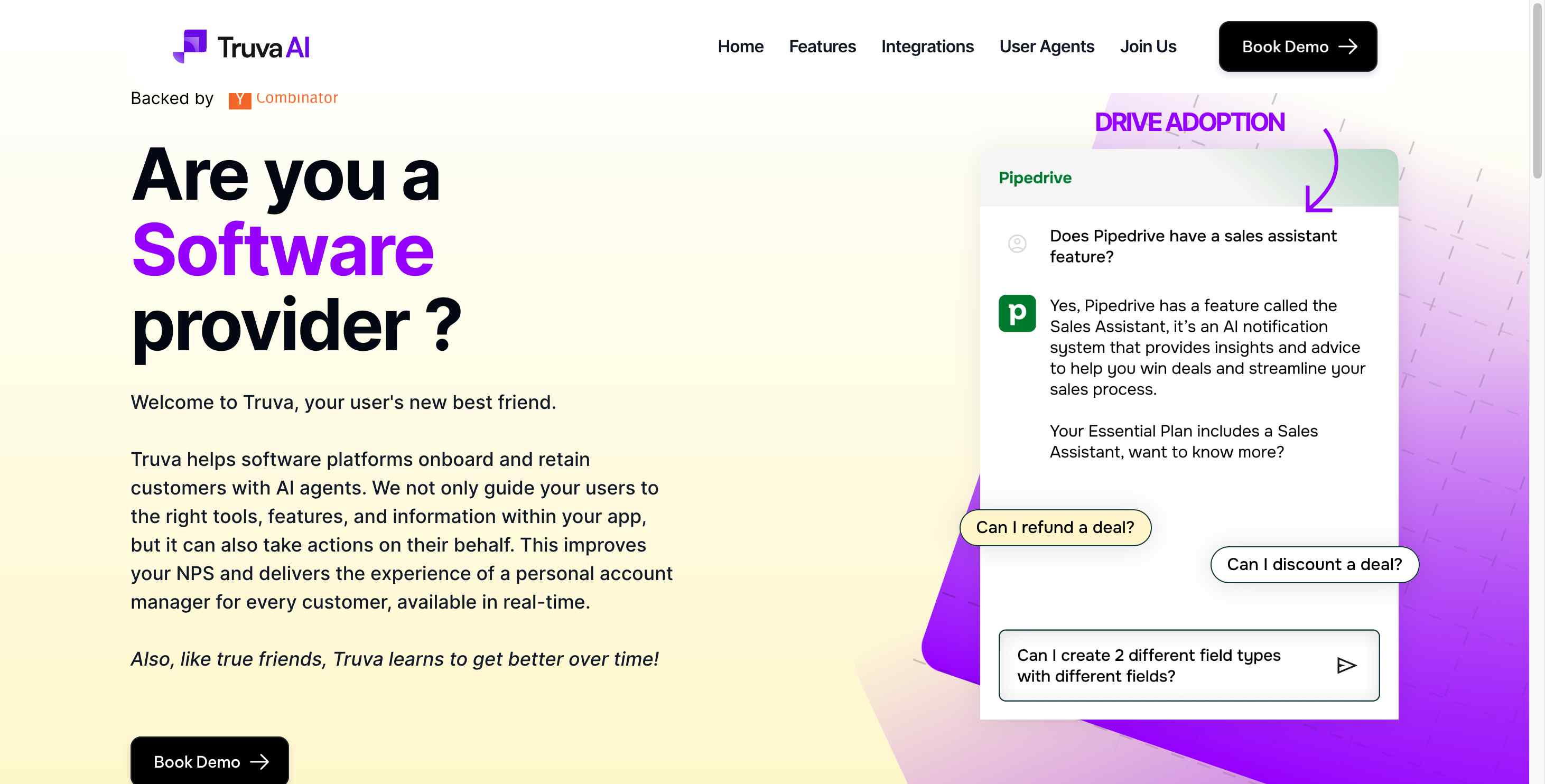
For businesses seeking to enhance user experience and operational efficiency with AI-driven personalized guidance, Truva.ai stands out as a top choice in 2024 and beyond. Leveraging AI and ML-powered algorithms, Truva.ai offers seamless integration with zero onboarding effort, making it ideal for SaaS platforms, educational tools, and e-commerce sites.
Key features include in-app support, chatbot functionality, and detailed analytics that provide deep insights into user behavior. With powerful multilingual support and intuitive software navigation, it simplifies user onboarding and reduces the need for extensive customer support teams. Additionally, Truva.ai guarantees robust data security with encryption and strict handling policies, offering a trial period to showcase its impact on operations without initial investment.
AI Tools Related Articles – Entrepreneurship and Productivity
Enhancing Business Productivity with AI
- Boost Your Business Productivity with the Best AI Tools
- Top AI Tools for Effective Email Management
- 8 Essential AI Marketing Tools for Modern Businesses
- AI Innovations in Influencer Marketing

Best For: Businesses of all sizes, especially SaaS platforms, educational tools, and e-commerce sites, seeking to enhance user experience and operational efficiency with AI-driven personalized guidance.
Pros:
- Seamless integration with zero onboarding effort.
- Powerful analytics and multilingual support for global applications.
- Robust data security with encryption and strict handling policies.
Cons:
- Dependence on AI might limit customization for niche requirements.
- Initial trial period may not be sufficient for full evaluation.
- Requires a continuous internet connection for optimal performance.
Univi – AI Meditation Sessions
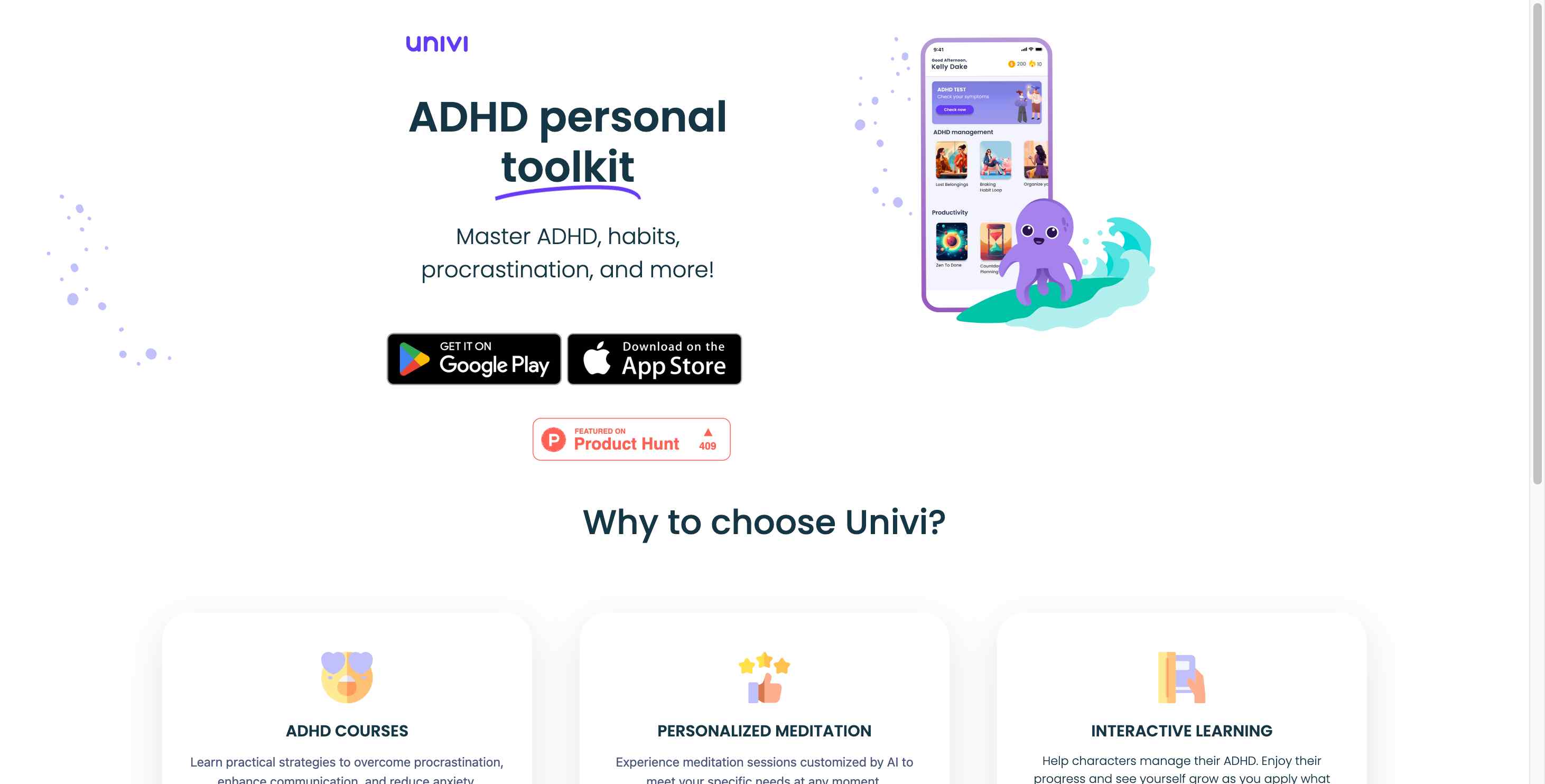
Univi, with its thorough meditation sessions and interactive learning features, is an essential AI tool for individuals seeking to enhance their productivity and manage ADHD effectively in 2024.
This innovative tool offers a holistic approach through video courses, a customizable to-do list, and a supportive community. Univi‘s AI technology tailors meditation sessions to users’ emotional states, helping to reduce anxiety and overcome procrastination.
Active engagement with video courses and consistent participation in interactive learning can greatly improve communication skills and daily coping mechanisms for ADHD. The tool’s pricing is competitive, and it stands out with its unique features compared to alternatives in the market.
Maximizing the Univi experience involves active engagement, customization, and consistency, fostering a productive and balanced lifestyle.
Best For: Individuals seeking a holistic AI tool to enhance productivity and manage ADHD effectively through personalized meditation, video courses, and interactive learning.
Pros:
- Personalized AI-tailored meditation sessions
- Comprehensive video courses and interactive learning
- Supportive community and customizable to-do list
Cons:
- Requires consistent engagement for best results
- May have a learning curve for new users
- Limited information on integration with other productivity tools
VASA-1 By Microsoft Research – Real-Time Animation Capabilities
VASA-1 by Microsoft Research stands out for its real-time animation capabilities, making it an ideal choice for industries requiring highly realistic facial movement synchronization and enhanced digital content creation. Leveraging deep learning techniques, VASA-1 provides instant talking faces with impressive audio-visual synchronization, ensuring convincing animations.
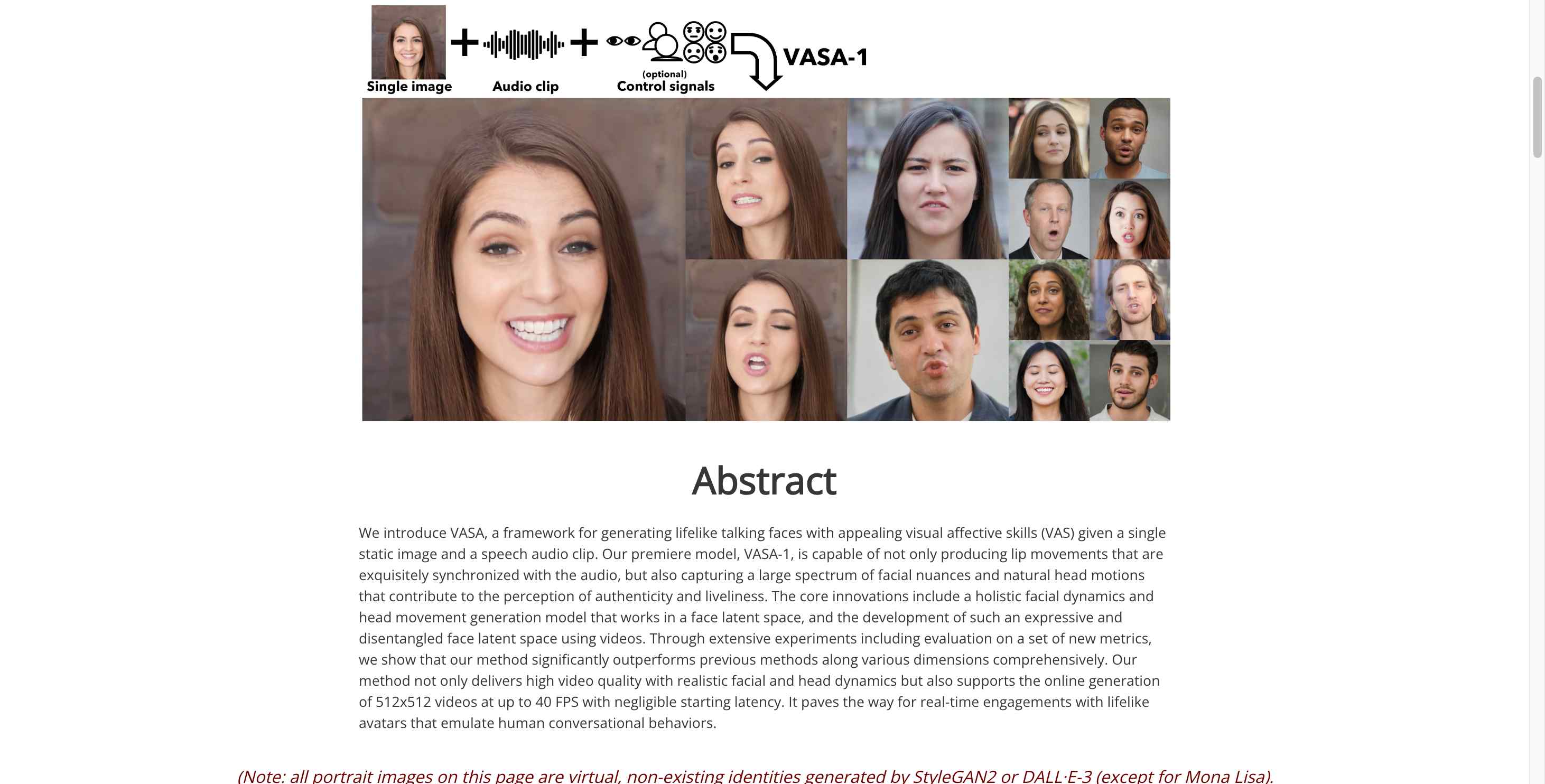
This tool’s versatility extends to various sectors, particularly benefiting digital communication and content creation. Additionally, VASA-1 features accessibility options for the hearing impaired, broadening its usability. The AI algorithm synthesizes nuanced facial movements, offering immediate feedback and improving interaction quality.
VASA-1’s ability to integrate with other applications further enhances digital interactions, making it a standout feature in the AI marketplace. Key industries poised to benefit include entertainment, education, and virtual communication platforms.
Best For: Industries and professionals seeking highly realistic and synchronized facial animations for enhanced digital communication and content creation.
Pros:
- Real-time animation with instant feedback.
- High-quality audio-visual synchronization.
- Accessibility features for the hearing impaired.
Cons:
- Potential integration challenges with non-compatible applications.
- High computational requirements for real-time processing.
- Limited to sectors where facial animations are crucial.
Collov AI – AI Driven Art Creation
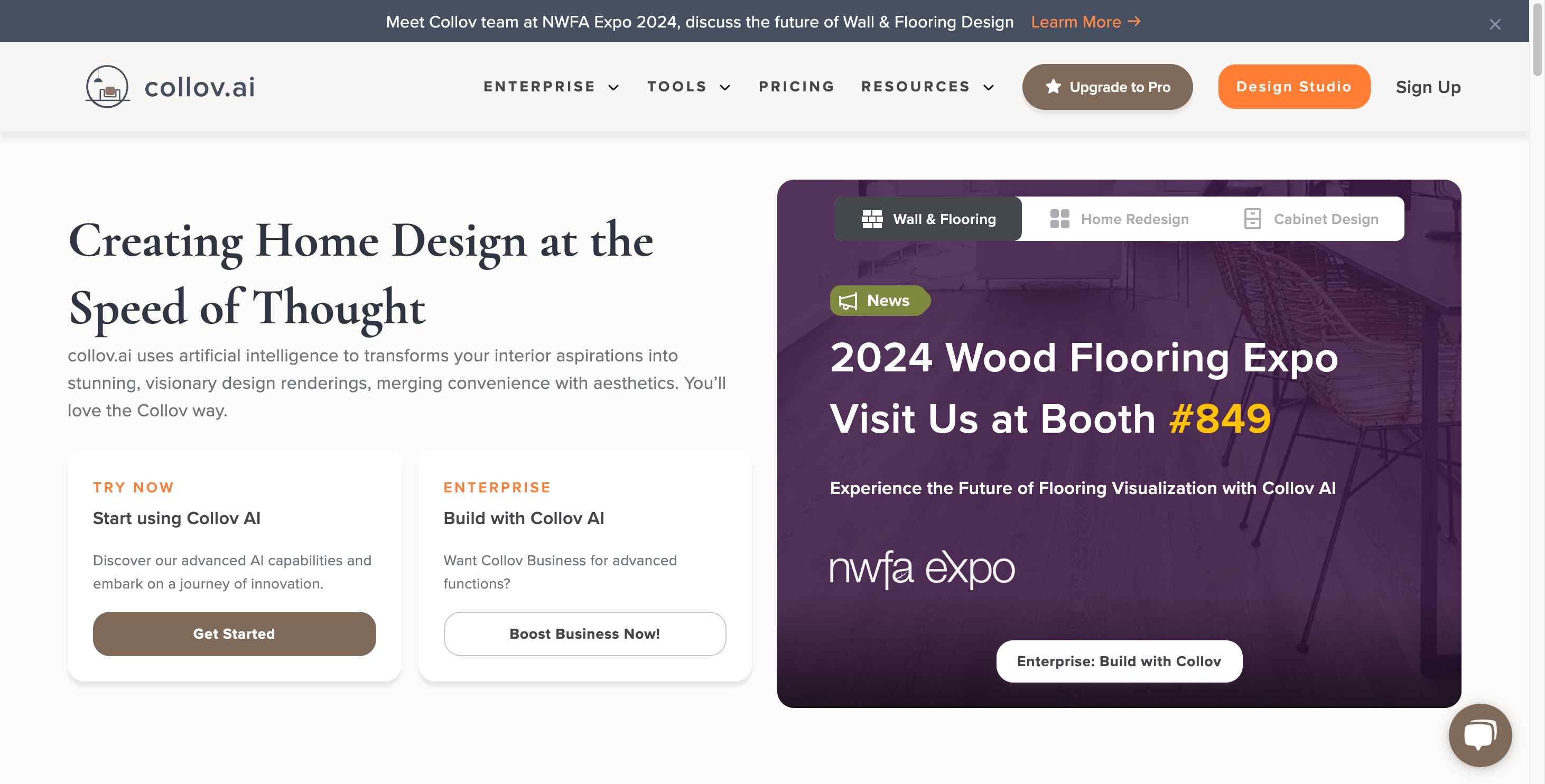
Collov AI, with its AI-Driven Art Creation and real-time customization, is an ideal choice for both professional designers and real estate developers seeking detailed visualizations and rapid rendering capabilities. Its flexibility and versatility cater to projects of all sizes, providing an intuitive user experience suitable for both amateurs and professionals.
Collov AI’s features include AI-Powered Efficiency, extensive functionality, and a user-friendly interface, supported by regular updates and industry collaboration. Users can explore diverse design options, take style quizzes, and leverage the AI Design Studio for speedy, high-accuracy designs.
The platform also facilitates community engagement and professional designer assistance, ensuring up-to-date design trends and robust support. Its rapid rendering makes it a valuable asset for real estate developers and home improvement projects.
Best For: Professional designers and real estate developers looking for detailed visualizations and rapid rendering capabilities.
Pros:
- AI-driven art creation with real-time customization
- Intuitive user experience for both amateurs and professionals
- Regular updates and industry collaboration
Cons:
- May require a learning curve for new users
- Limited to design and visualization applications
- Dependence on AI may reduce creative control for some users
Factors to Consider When Choosing Future Tools AI

When choosing AI tools for the future, I focus on several key factors.
Integration capabilities and customization options are essential for seamless implementation and flexibility.
Additionally, user experience, data security, and cost efficiency play significant roles in my decision-making process.
Integration Capabilities
When evaluating future AI tools, it’s important to guarantee they integrate smoothly with your existing software systems and tools for optimal workflow efficiency. I always look for tools that offer APIs or SDKs because they facilitate easy integration with other applications. This ensures that the new AI tool can work harmoniously with the software I’m already using, minimizing disruptions and technical challenges.
Checking compatibility with my existing infrastructure is essential. It’s frustrating to invest in a promising AI tool only to find out it doesn’t play well with my current setup. By evaluating this upfront, I can avoid unnecessary headaches down the road.
I also pay attention to whether the AI tool can integrate with popular platforms and services commonly used in my industry. This broad compatibility often indicates a well-thought-out product that’s designed to fit into various workflows seamlessly.
Interoperability and data exchange capabilities are other key factors I consider. The AI tool should support smooth data flows with my existing technology stack. This ensures that I can leverage the full potential of both the new AI tool and my current systems, leading to more efficient operations overall.
Customization Options
Customization options play an essential role in guaranteeing AI tools meet my unique needs and preferences. When evaluating AI tools, I always consider the level of customization they offer. This includes the ability to tailor features, interfaces, workflows, and outputs to optimize performance for my specific requirements. Tools that offer robust customization allow me to fine-tune the AI to better align with my business goals and operational needs.
I also look at the scalability of these customization features. As my business evolves and grows, I need my AI tools to adapt accordingly. Scalable customization ensures that the tools I invest in today will still be relevant and effective as my needs change over time. This adaptability is vital for maintaining efficiency and effectiveness.
Moreover, the ability to personalize AI tools enhances my overall experience with the technology. When I can configure an AI tool to meet my unique requirements, the outcomes are invariably better. It leads to increased satisfaction and a more significant return on investment.
To summarize, thoughtful customization options aren’t just a nice-to-have; they’re a critical factor in the successful implementation and long-term viability of AI solutions.
User Experience
A top priority for me when choosing future AI tools is ensuring they offer an exceptional user experience. I look for ease of use and intuitive interfaces that make using the tool straightforward. Streamlined workflows are essential for enhancing my satisfaction and productivity. Customization options and personalization features are also critical; I want tools that adapt to my needs, not the other way around. Interactive elements that engage me and make the experience more dynamic are a big plus.
User experience design principles are vital. I value user-centric design, which guarantees the tool aligns with my requirements and preferences. Accessibility is another key factor; the tool should be usable by everyone, regardless of ability. Responsiveness, both regarding speed and adaptability across devices, is crucial for maintaining a smooth experience.
Effective user experience design can lead to increased engagement and higher adoption rates. To optimize this, continuous feedback gathering and usability testing are essential. Iterative improvements based on this feedback ensure the tool evolves to meet user needs better over time. By focusing on these aspects, future AI tools can provide a user experience that enhances overall productivity and satisfaction.
Data Security
Ensuring robust data security in AI tools is paramount to protecting sensitive information and maintaining user trust. When choosing future AI tools, I always prioritize encryption techniques. These methods shield sensitive data from unauthorized access, guaranteeing that only those with the correct decryption key can view the information.
Compliance with data privacy regulations like GDPR is another critical factor. Adhering to these regulations guarantees that user data is managed ethically and securely, which is essential for maintaining both legal compliance and user confidence. Regular security audits and updates are also indispensable. These practices help identify and fix vulnerabilities, reducing the risk of data breaches and ensuring that the AI tools remain secure over time.
Secure data storage methods play a significant role in data protection. Utilizing cloud services with robust security measures ensures that data is safely stored and guarded against potential threats.
Lastly, implementing access controls and user authentication protocols adds an extra layer of security. By restricting data access to authorized users only, I can better protect sensitive information from falling into the wrong hands.
Creative Applications of AI
- Develop Your Free AI App with Llama 3
- Exploring AI in Songwriting: Creative Potentials
- Amazon’s Quantum Leap in AI Technology
AI in Communication and Media
- Revolutionizing Media with the Best AI Voice Cloning Software
- Meet the Top 6 Celebrity AI Voice Generators
- Transforming Interactions: Chatbots and GPT-2
- ChatGPT’s Role in Humanizing Digital Communications
- AI’s Breakthrough in Transcription Services
Cost Efficiency
When selecting future AI tools, I always consider both the initial investment and the long-term costs to guarantee cost efficiency. It’s important to not just look at the price tag but also evaluate the potential savings in time and resources these tools can provide compared to traditional methods. By doing this, I can make sure that the AI tools I choose will offer a good return on investment.
I also make a point to search for AI tools that offer scalable pricing models. This flexibility allows the tools to grow with my needs, accommodating changes in usage without causing financial strain. Another critical factor I consider is the impact on productivity, revenue generation, and cost reduction. By analyzing these elements, I can better assess the ROI of the AI tools.
Moreover, the potential for cost savings through automation, improved accuracy, and reduced human error is significant. These benefits can lead to substantial financial advantages over time, making the initial investment worthwhile. By focusing on these cost efficiency factors, I make sure that the AI tools I implement aren’t only effective but also economically sustainable in the long run.
Discover AI Integrations and Educational Resources
- AI Tool Categories & Integrations
- AI Courses for Enthusiasts and Professionals
- Submit a Tool to Popular AI Tools
- Advertise Your AI Solutions
Explore Featured AI Tools and Blogs
- Explore GPTs and Their Capabilities
- Featured AI Tools for Various Needs
- AI Blog for Latest News and Tips
- 9 Best AI Essay Writers of 2024
Scalability Potential
Scalability potential is a key factor I prioritize to guarantee that the AI tool can adapt to growing demands and evolving business needs. When choosing an AI tool, I look for cloud computing capabilities, modular design, and flexible architecture. These elements collectively ensure the tool can handle larger datasets, increased user interactions, and evolving business requirements without compromising performance.
One significant benefit of scalability is its ability to support business growth seamlessly. An AI tool with high scalability potential can accommodate new features and efficiently scale resources, ensuring it remains robust as the business expands. This adaptability is essential for future-proofing the tool, enabling it to meet dynamic market conditions and customer expectations.
Moreover, scalability optimizes performance in dynamic environments. As user interactions and data volumes grow, a scalable AI tool can seamlessly expand its capabilities, maintaining efficiency and reliability. This not only enhances user experience but also ensures that the tool continues to deliver value as demands increase.
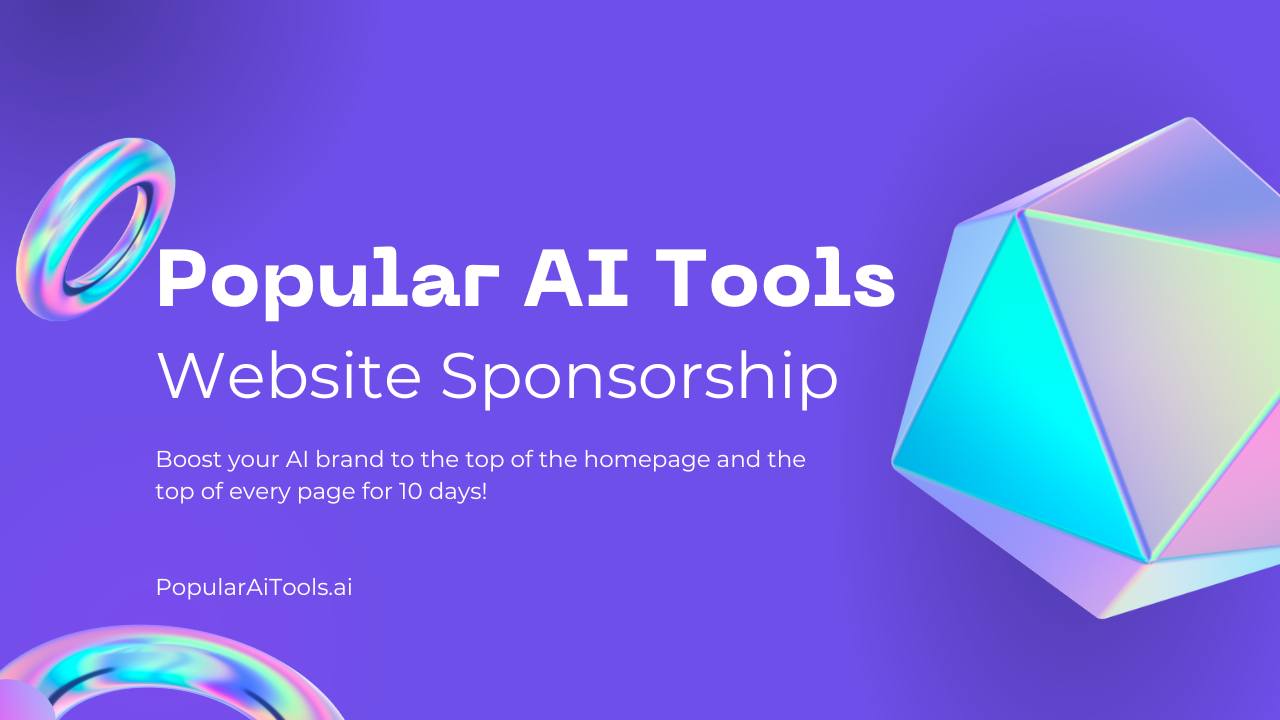
Support Resources
Beyond scalability, I also place high importance on the support resources available for future AI tools. Extensive online documentation, tutorials, and knowledge bases are invaluable. They help me understand tool functionalities and troubleshoot issues efficiently. I always look for AI tools that offer these resources because they empower me to solve problems independently.
Community forums and user groups are another vital aspect. The collective wisdom found in these spaces provides valuable insights, tips, and best practices. Engaging with other users often reveals practical solutions and innovative ways to maximize the tool’s potential.
Responsive customer support services, such as live chat, email, or phone assistance, are essential for real-time help. When I encounter a problem that I can’t resolve through documentation or community advice, having access to prompt and knowledgeable support makes a significant difference.
Regular software updates and maintenance releases also matter. They ensure I’ve access to the latest features, improvements, and bug fixes, contributing to a seamless user experience.
Lastly, educational resources like webinars, workshops, and training courses are vital. They enhance my skills and proficiency, enabling me to use AI tools more effectively and stay ahead in a rapidly evolving field.
Technological Innovation
As I evaluate future AI tools, I consider technological innovation critical to their potential impact and effectiveness. Advancements in deep learning algorithms, neural networks, and natural language processing are pivotal. These innovations not only enhance the tools’ capabilities but also broaden their application across various sectors.
Cutting-edge technologies like reinforcement learning and generative adversarial networks are particularly exciting. They push the boundaries of what AI can achieve, enabling more sophisticated and responsive tools. Features like real-time processing and seamless integration with existing systems are essential. They guarantee that the AI tools can be implemented without significant disruptions, maximizing their utility.
Adaptive learning capabilities are another key factor. AI tools that can learn and evolve with usage provide ongoing value and remain relevant over time. The impact of cloud computing, edge computing, and quantum computing can’t be overstated. These technologies drive the evolution of AI tools, making them more powerful and accessible.
Ultimately, technological innovation in AI tools focuses on enhancing user experience, improving efficiency, and enabling automation. These elements are critical for any industry looking to leverage AI for competitive advantage.
Therefore, when choosing future AI tools, evaluating the technological advancements they incorporate is indispensable.
Dive Into AI Tool Categories and Reviews
Frequently Asked Questions
What Are the Key Benefits of Using AI Tools in 2024?
Using AI tools in 2024 offers incredible benefits. I can streamline tasks, enhance productivity, and make data-driven decisions faster.
AI tools enable personalized experiences and improve accuracy in predictions. They also reduce human error and can handle repetitive tasks, freeing up time for more creative endeavors.
These tools make my work more efficient and help me stay competitive in an ever-evolving landscape.
How Can AI Tools Improve Productivity in Various Industries?
AI tools can greatly enhance productivity across various industries. In my experience, they streamline tasks, automate repetitive processes, and provide valuable insights through data analysis.
For example, in healthcare, AI improves patient diagnostics and treatment plans. In manufacturing, it optimizes supply chains and predictive maintenance.
Are There Any Security Concerns With Using AI Tools?
Yes, there are definitely security concerns with using AI tools. I worry about data breaches, as these tools often require access to sensitive information. Hackers could exploit vulnerabilities in the AI’s code or use it to launch sophisticated attacks.
Additionally, there’s the risk of AI making biased decisions due to flawed training data, which can have serious ethical and security implications. It’s essential to implement robust security measures.
How Do AI Tools Integrate With Existing Software Systems?
Integrating AI tools with existing software systems is like fitting a new piece into a jigsaw puzzle. I prioritize compatibility by using APIs and middleware that bridge the gap between different platforms.
It’s essential to understand the existing infrastructure, so I map out the workflows and data exchange points. This way, the AI tools seamlessly enhance functionality without disrupting the current system’s operations.
What Are the Ethical Considerations When Deploying AI Technologies?
When deploying AI technologies, I’ve to contemplate several ethical issues. Privacy is a significant one; I need to guarantee sensitive data isn’t mishandled.
Bias is another concern, as AI systems can unintentionally reinforce stereotypes.
Transparency is essential too, so users understand how decisions are made.
Lastly, I must think about accountability, ensuring there’s a clear way to address any harm caused by the AI.
Why should game developers, marketers, and graphic designers consider RenderNet for their 2024 projects?
RenderNet offers an all-inclusive suite of features, including FaceLock, ControlNet, ChangeIt, and Multi-model Generations, which streamline and enhance design processes. It ensures consistency in character design, efficiency, and speed, making it invaluable for complex projects like video games, animated series, marketing campaigns, and digital advertising. Its user-friendly interface and robust support through documentation and tutorials facilitate seamless integration with other design tools, making it cost-effective and accessible for small businesses and startups.
What are the main benefits of RenderNet?
RenderNet provides consistency in character design and visual branding, a user-friendly interface with comprehensive support and tutorials, and cost-effectiveness for small businesses and startups.
What are the drawbacks of RenderNet?
RenderNet may have a learning curve for new users, requires integration with other design tools for full functionality, and its advanced features may be overwhelming for beginners.
Why is Truva.ai a top choice for 2024 and beyond?
Truva.ai leverages AI and ML-powered algorithms to offer seamless integration with zero onboarding effort, making it ideal for SaaS platforms, educational tools, and e-commerce sites. Key features include in-app support, chatbot functionality, and detailed analytics that provide deep insights into user behavior. It also offers powerful multilingual support, intuitive software navigation, and robust data security with encryption and strict handling policies.
What are the main benefits of Truva.ai?
Truva.ai provides seamless integration with zero onboarding effort, powerful analytics and multilingual support for global applications, and robust data security with encryption and strict handling policies.
What are the drawbacks of Truva.ai?
Dependence on AI might limit customization for niche requirements, the initial trial period may not be sufficient for full evaluation, and it requires a continuous internet connection for optimal performance.
How does Univi enhance productivity and manage ADHD?
Univi offers thorough meditation sessions and interactive learning features tailored to users’ emotional states, helping to reduce anxiety and overcome procrastination. It includes video courses, a customizable to-do list, and a supportive community. Active engagement with video courses and consistent participation in interactive learning can greatly improve communication skills and daily coping mechanisms for ADHD.
What are the main benefits of Univi?
Univi provides personalized AI-tailored meditation sessions, comprehensive video courses and interactive learning, and a supportive community with a customizable to-do list.
What are the drawbacks of Univi?
Univi requires consistent engagement for best results, may have a learning curve for new users, and offers limited information on integration with other productivity tools.
What makes VASA-1 by Microsoft Research stand out?
VASA-1 by Microsoft Research utilizes deep learning techniques to provide real-time facial animation with impressive audio-visual synchronization, making it ideal for industries requiring highly realistic facial movement synchronization and enhanced digital content creation. It features accessibility options for the hearing impaired and synthesizes nuanced facial movements, offering immediate feedback and improving interaction quality.
What are the main benefits of VASA-1?
VASA-1 offers real-time animation with instant feedback, high-quality audio-visual synchronization, and accessibility features for the hearing impaired.
What are the drawbacks of VASA-1?
VASA-1 may face integration challenges with non-compatible applications, requires high computational power for real-time processing, and is limited to sectors where facial animations are crucial.
How does Collov AI benefit professional designers and real estate developers?
Collov AI provides AI-driven art creation with real-time customization, offering detailed visualizations and rapid rendering capabilities. Its user-friendly interface caters to both amateurs and professionals. Key features include AI-powered efficiency, extensive functionality, and regular updates supported by industry collaboration. It facilitates community engagement and professional designer assistance.
What are the main benefits of Collov AI?
Collov AI offers AI-driven art creation with real-time customization, an intuitive user experience for both amateurs and professionals, and regular updates with industry collaboration.
What are the drawbacks of Collov AI?
Collov AI may require a learning curve for new users, is limited to design and visualization applications, and its dependence on AI may reduce creative control for some users.
What factors should be considered when choosing future AI tools?
When choosing AI tools, consider integration capabilities and customization options for seamless implementation and flexibility. User experience, data security, and cost efficiency are also crucial. Evaluate the tool’s ability to integrate with existing systems, its customization features, user-centric design, robust security measures, and cost-saving potential.
Conclusion
Choosing the right AI tool is like exploring a vast ocean of possibilities. Each tool, from RenderNet to Collov AI, represents a unique vessel, equipped with distinct capabilities and features.
Your journey to the future of technology will depend on the ship you board. So, hoist your sails and steer wisely—your choice today will chart the course for tomorrow’s success.
Remember, even in uncharted waters, the right compass can guide you to new horizons.

